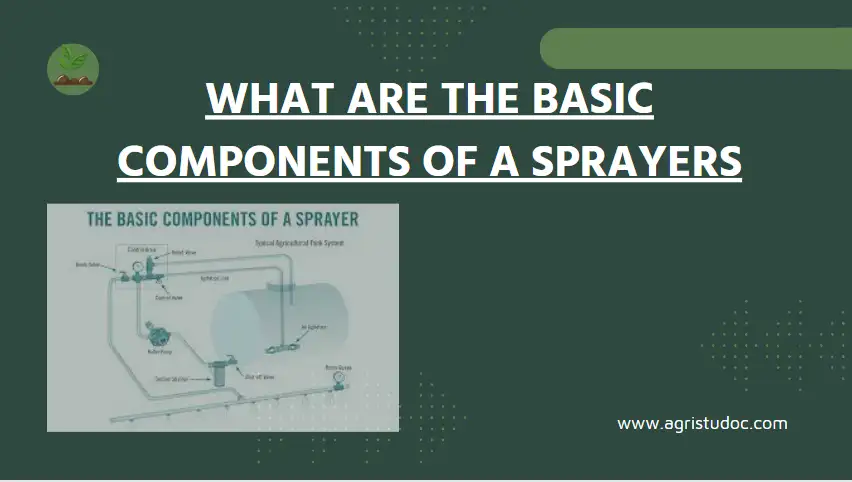Sprayers play an important role in agriculture. Understanding their components is crucial for effective use. The components of a sprayers are the nozzle, agitator, pump, tank, pressure regulator, and boom are integral parts ensuring precise and efficient crop spraying.
What is a sprayer?
A sprayer is a machine used to apply liquid chemicals to plants to control pests and diseases. It can also be used to apply herbicides to control weeds and spray micro-nutrients to enhance plant growth.
The main functions of a sprayer are:
1. Breaking the chemical solution into fine droplets of effective size.
2. Distribute the droplets uniformly over the plants.
3. Applying the chemicals with sufficient pressure for Positive to reach the plants
4. Regulate the amount of liquid applied to plants to avoid excessive application.
Components of a Sprayers are:
There are many components of a sprayers that are described as follows:
- Pump
- Chemical Tank
- Agitator
- Air Chamber
- Pressure Gauge
- Pressure Regulator
- Valves
- Strainer
- Suction Line
- Delivery Line
- Nozzles
- Spray Gun and
- Spray Boom, etc.
1. Pump:
A pump is a device used to move fluids, such as liquids, slurries, or gases from one place to another. This components of a sprayers displaces a volume by physical or mechanical action. Most hydraulic sprayers are equipped with positive displacement pumps capable of developing pressure, required for many spraying jobs. The discharge capacity of these pumps is approximately proportional to the speed. A pressure relief valve or bypass valve is required to protect these positive-acting pumps from damage when the discharge line is closed and for the convenience of the operator.
2. Tank:
It is the container to holds the chemical solution. It is made up of PVC, Brass, etc. It is usually made of metal sheet or synthetic rubber or plastic having good resistant quality against corrosion, erosion, and similar actions. The size of the tank varies according to the pump capacity and the requirements.
3. Agitator:
It is also main components of a sprayers, the device that stirs the solution and keeps the contents in a homogenous condition. Positive agitation of spray material in the tank is essential to permit the use of the full range of spray materials including powdery emulsions, fungicides, cold water paints, or other spray material. Propeller or paddle-type mechanical agitators or hydraulic agitators are very common.
4. Air Chamber:
In a reciprocating type pump, an air chamber is provided on the discharge line of the pump to level out the pulsations of the pump thus providing a constant nozzle pressure.
5. Pressure Gauge:
It is a dial gauge which indicates the pressure at which the liquid is delivered from the pump. A pressure gauge properly calibrated, within the pressure range of the pump, is provided on the discharge line to guide the operator in making proper adjustments to the pressure at the site.
6. Pressure Regulator:
The pressure regulator serves several important functions. It means of adjusting the pressure as required for any spray job within the pressure range of the pump. The positive displacement type of pump, it also serves as a safety device in automatically unloading the excess pressure by directing the unused discharge flow from the pump back to the tank.
7. Valves:
A valve is a device that regulates the flow of a fluid (gases, liquids, fluidized solids, or slurries) by opening, closing, or partially obstructing various passageways.
A cut-off valve is provided in the delivery line to control the flow from the pump.
A bypass valve is provided in the delivery line to bypass the flow from the pump to the tank when the flow in the delivery line is reduced than the pump capacity.
A relief valve is an automatic device to control the pressure of fluid or gas within a range of a predetermined pressure.
8. Strainer:
It is a small circular plastic ring with nylon wire mesh to filter any dust particles coming with the chemical solutions. It is included in the suction line between the chemical tank and the check valves. In some sprayers, strainers are provided at the mouth of the chemical tank. Eg. Knapsack sprayers.
9. Nozzles:
It is the components of a sprayers that breaks the fluid into fine droplets. Automation of spray fluid is usually achieved by discharging the liquid through an orifice called a nozzle under pressure. Automation is also achieved by breaking up the jet of liquid with a blast of air.
10. Spray Gun:
It is a hand-held metallic of PVC pipe to one end of which the nozzle is fitted and a flow cut-off valve and a handle are fitted at the other end. The delivery hose is connected to the spray gun. It conducts the fluid from the delivery hose to the nozzle. The operator holds the gun and does the spraying job. The area of coverage by a spray gun is less compared to the coverage of a spray boom. Spray guns are used with low-power sprayers. Eg. Knapsack sprayers and rocker sprayers.
11. Spray Boom:
It is a long metallic or PVC pipe with which several nozzles are fitted. The delivery hose is connected to the spray gun. High-power and high-capacity sprayers use spray booms. The coverage is larger compared to spray guns. Booms are usually mounted on suitable structures and used. Eg. Tractor-operated sprayers, and Power tiller-operated sprayers, etc are the main components of a sprayers.
Also Read:
Crop Rotation: Objectives, Principles, Advantages & Disadvantages
Agricultural Meteorology: Meaning, Importance and Scope
Component Of Organic Farming In India

